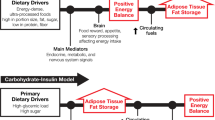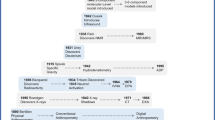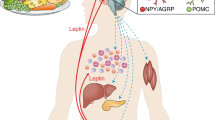Abstract
In this work, we reflect upon the energy balance hypothesis of obesity. International organizations, the general population and many scientists hold the belief that obesity is indisputably caused by an imbalance between energy intake and energy expenditure. Most of them argue that the laws of thermodynamics support this view. We identify and review the main arguments used to support this belief, and we explain the reasoning mistakes those arguments harbor. We show that the laws of thermodynamics do not support the idea that obesity is an energy problem nor an energy balance problem more than they do in the growth of any other tissue in the human body. We argue that the validity of the energy balance paradigm for obesity must be questioned. Although correction of a wrong belief is laudable per se, in this particular case harm may arise by influencing the way in which obesity prevention is tackled and obese patients are treated.

This is a preview of subscription content, access via your institution
Access options
Subscribe to this journal
Receive 12 print issues and online access
$259.00 per year
only $21.58 per issue
Buy this article
- Purchase on Springer Link
- Instant access to full article PDF
Prices may be subject to local taxes which are calculated during checkout







Similar content being viewed by others
References
Ng M, Fleming T, Robinson M, Thomson B, Graetz N, Margono C, et al. Global, regional, and national prevalence of overweight and obesity in children and adults during 1980–2013: a systematic analysis for the Global Burden of Disease Study 2013. Lancet. 2014;384:766–81.
Swinburn BA. Obesity prevention: the role of policies, laws and regulations. Aust New Zealand Health Policy. 2008;5:12–8.
Hill JO, Wyatt HR, Peters JC. The importance of energy balance. Eur Endocrinol. 2013;9:111–5.
Newburgh LH, Woodwell Johnston M. Endogenous obesity—a misconception. Ann Intern Med. 1930;3:815–25.
Yudkin J. The causes and cure of obesity. Lancet. 1959;274:1135–8.
Hervey GR. Physiological mechanisms for the regulation of energy balance. Proc Nutr Soc. 1971;30:109–16.
Rosen ED, Spiegelman BM. Adipocytes as regulators of energy balance and glucose homeostasis. Nature. 2006;444:847–53.
Caballero B. The global epidemic of obesity: an overview. Epidemiol Rev. 2007;29:1–5.
Booth DA, Nouwen A. Satiety. No way to slim. Appetite. 2010;55:718–21.
Johnson LM. The genetic epidemiology of obesity: a case study. Genetic Epidemiology. Methods in Molecular Biology (Methods and Protocols), vol 713. In: Teare M, editor. Totowa, NJ: Humana Press; 2011. p. 227–37.
Frayn KN. Metabolic Regulation : A Human Perspective. Hoboken: John Wiley & Sons, Incorporated; 2010.
Walsh JA. Obesity & the First Law of Thermodynamics. Am Biol Teach. 2013;75:413–5.
Varela Moreiras G, Ávila JM, Ruiz E. Energy balance, a new paradigm and methodological issues: the ANIBES study in Spain. Nutricion Hospitalaria. 2015;31:101–12.
Hume DJ, Yokum S, Stice E. Low energy intake plus low energy expenditure (low energy flux), not energy surfeit, predicts future body fat gain. Am J Clin Nutr. 2016;103:1389–96.
Schwartz MW, Seeley RJ, Zeltser LM, Drewnowski A, Ravussin E, Redman LM, et al. Obesity pathogenesis: an Endocrine Society scientific statement. Endocr Rev. 2017;38:267–96.
Piaggi P. Metabolic determinants of weight gain in humans. Obesity. 2019;27:691–9.
Puhl RM, Phelan SM, Nadglowski J, Kyle TK. Overcoming weight bias in the management of patients with diabetes and obesity. Clin Diabetes. 2016;34:44–50.
Nichols BL. Atwater and USDA nutrition research and service: a prologue of the past century. J Nutr. 1994;124:1718S–27S.
Pennington AW. A reorientation on obesity. N. Engl J Med. 1953;248:959–64.
Noorden CV. Metabolism and practical medicine. Vol. III. William Heinemann; 1907.
Taubes G. Good calories, bad calories: fats, carbs, and the controversial science of diet and health. New York: Knopf; 2007.
Ludwig DS, Ebbeling CB. The carbohydrate-insulin model of obesity: beyond “Calories In, Calories Out”. JAMA Intern Med. 2018;178:1098–103.
Sztalryd C, Hamilton J, Horwitz BA, Johnson P, Kraemer FB. Alterations of lipolysis and lipoprotein lipase in chronically nicotine-treated rats. Am J Physiol-Endocrinol Metab. 1996;270:E215–23.
Camps SG, Kaur B, Quek RYC, Henry CJ. Does the ingestion of a 24 h low glycaemic index Asian mixed meal diet improve glycaemic response and promote fat oxidation? A controlled, randomized cross-over study. Nutr J. 2017;16:43.
Lee M-S, Kim I-H, Kim C-T, Kim Y. Reduction of body weight by dietary garlic is associated with an increase in uncoupling protein mRNA expression and activation of AMP-activated protein kinase in diet-induced obese mice. J Nutr. 2011;141:1947–53.
Chen VP, Gao Y, Geng L, Stout MB, Jensen MD, Brimijoin S. Butyrylcholinesterase deficiency promotes adipose tissue growth and hepatic lipid accumulation in male mice on high-fat diet. Endocrinology. 2016;157:3086–95.
Dugas LR, Harders R, Merrill S, Ebersole K, Shoham DA, Rush EC, et al. Energy expenditure in adults living in developing compared with industrialized countries: a meta-analysis of doubly labeled water studies. Am J Clin Nutr. 2011;93:427–41.
Witte MM, Resuehr D, Chandler AR, Mehle AK, Overton JM. Female mice and rats exhibit species-specific metabolic and behavioral responses to ovariectomy. Gen Comp Endocrinol. 2010;166:520–8.
Carlson MG, Campbell PJ. Intensive insulin therapy and weight gain in IDDM. Diabetes. 1993;42:1700–7.
St-Onge M-P, Bosarge A. Weight-loss diet that includes consumption of medium-chain triacylglycerol oil leads to a greater rate of weight and fat mass loss than does olive oil. Am J Clin Nutr. 2008;87:621–6.
Martin CK, Johnson WD, Myers CA, Apolzan JW, Earnest CP, Thomas DM, et al. Effect of different doses of supervised exercise on food intake, metabolism, and non-exercise physical activity: The E-MECHANIC randomized controlled trial. Am J Clin Nutr. 2019;110:583–92.
Bouchard C. The magnitude of the energy imbalance in obesity is generally underestimated. Int J Obes. 2008;32:879–80.
Bray GA, Champagne CM. Beyond energy balance: there is more to obesity than kilocalories. J Am Dietetic Assoc. 2005;105:S17–23.
Schrauwen P, Hesselink M. UCP2 and UCP3 in muscle controlling body metabolism. J Exp Biol. 2002;205:2275–85.
Casazza K, Fontaine KR, Astrup A, Birch LL, Brown AW, Bohan Brown MM, et al. Myths, presumptions, and facts about obesity. N. Engl J Med. 2013;368:446–54.
American Medical Association. A critique of low-carbohydrate ketogenic weight reduction regimens: a review of Dr. Atkins’ diet revolution. Nutr Rev. 1974;32:15–23.
Joshi S, Ostfeld RJ, McMacken M. The ketogenic diet for obesity and diabetes—enthusiasm outpaces evidence. JAMA Intern Med. 2019;179:1163–4.
Ravussin E, Beyl RA, Poggiogalle E, Hsia DS, Peterson CM. Early time‐restricted feeding reduces appetite and increases fat oxidation but does not affect energy expenditure in humans. Obesity. 2019;27:1244–54.
Pearl J. 3. The foundations of causal inference. Sociol Methodol. 2010;40:75–149.
Zając A, Wilk M, Socha T, Maszczyk A, Chycki J. Effects of growth hormone and testosterone therapy on aerobic and anaerobic fitness, body composition and lipoprotein profile in middle-aged men. Ann Agric Environ Med. 2014;21:156–60.
Jackman MR, MacLean PS, Bessesen DH. Energy expenditure in obesity-prone and obesity-resistant rats before and after the introduction of a high-fat diet. Am J Physiol-Regulatory, Integr Comp Physiol. 2010;299:R1097–105.
Wetzler S, Jean C, Tomé D, Larue-Achagiotis C. A carbohydrate diet rich in sucrose increased insulin and WAT in macronutrient self-selecting rats. Physiol Behav. 2003;79:695–700.
Srivastava S, Baxa U, Niu G, Chen X, Veech RL. A ketogenic diet increases brown adipose tissue mitochondrial proteins and UCP1 levels in mice. IUBMB Life. 2013;65:58–66.
Cho I, Yamanishi S, Cox L, Methé BA, Zavadil J, Li K, et al. Antibiotics in early life alter the murine colonic microbiome and adiposity. Nature. 2012;488:621–6.
Do M, Lee E, Oh M-J, Kim Y, Park H-Y. High-glucose or -fructose diet cause changes of the gut microbiota and metabolic disorders in mice without body weight change. Nutrients. 2018;10:761.
Campbell WW, Barton J, Marvin L, Cyr-Campbell D, Davey SL, Beard JL, et al. Effects of an omnivorous diet compared with a lactoovovegetarian diet on resistance-training-induced changes in body composition and skeletal muscle in older men. Am J Clin Nutr. 1999;70:1032–9.
Barakat C, Pearson J, Escalante G, Campbell B, De Souza EO. Body recomposition: can trained individuals build muscle and lose fat at the same time? Strength Conditioning J. 2020;42:7–21.
Feinman RD, Fine EJ. Nonequilibrium thermodynamics and energy efficiency in weight loss diets. Theor Biol Med Model. 2007;4:27–39.
Agha M, Agha R. The rising prevalence of obesity: part A: impact on public health. Int J Surg Oncol. 2017;2:e17.
Gill TP, Boylan S. Public health messages: why are they ineffective and what can be done? Curr Obes Rep. 2012;1:50–8.
Hall KD, Sacks G, Chandramohan D, Chow CC, Wang YC, Gortmaker SL, et al. Quantification of the effect of energy imbalance on bodyweight. Lancet. 2011;378:826–37.
Hall KD, Kahan S. Maintenance of lost weight and long-term management of obesity. Med Clin North Am. 2018;102:183–97.
Franz MJ, VanWormer JJ, Crain AL, Boucher JL, Histon T, Caplan W, et al. Weight-loss outcomes: a systematic review and meta-analysis of weight-loss clinical trials with a minimum 1-year follow-up. J Am Dietetic Assoc. 2007;107:1755–67.
Mann T, Tomiyama AJ, Westling E, Lew A-M, Samuels B, Chatman J. Medicare’s search for effective obesity treatments: Diets are not the answer. Am Psychologist. 2007;62:220–33.
Must A, Spadano J, Coakley EH, Field AE, Colditz G, Dietz WH. The disease burden associated with overweight and obesity. JAMA. 1999;282:1523–9.
Puhl RM, Heuer CA. Obesity stigma: important considerations for public health. Am J Public Health. 2010;100:1019–28.
Puhl RM, Heuer CA. The stigma of obesity: a review and update. Obesity. 2009;17:941–64.
Rony HR. Obesity and leanness. Obes Res. 1995;3:609–24.
Pennington AW. Treatment of obesity: developments of the past 150 years. Am J Digestive Dis. 1954;21:65–9.
Taubes G. The science of obesity: what do we really know about what makes us fat? An essay by Gary Taubes. BMJ. 2013;346:f1050.
Wells JCK, Siervo M. Obesity and energy balance: is the tail wagging the dog? Eur J Clin Nutr. 2011;65:1173–89.
Wells JCK. Obesity as malnutrition: the dimensions beyond energy balance. Eur J Clin Nutr. 2013;67:507–12.
Hebert JR, Allison DB, Archer E, Lavie CJ, Blair SN. Scientific decision making, policy decisions, and the obesity pandemic. Mayo Clin Proc. 2013;88:593–604.
Chandaria SA. The emerging paradigm shift in understanding the causes of obesity. In: Controversies in obesity. London: Springer London; 2014. pp. 63–73.
Camacho S, Ruppel A. Is the calorie concept a real solution to the obesity epidemic? Glob Health Action. 2017;10:1289650.
Author information
Authors and Affiliations
Contributions
VTC conceived the first draft of the article. All authors contributed to the development of subsequent draft versions.
Corresponding author
Ethics declarations
Competing interests
The authors declare no competing interests.
Additional information
Publisher’s note Springer Nature remains neutral with regard to jurisdictional claims in published maps and institutional affiliations.
Rights and permissions
About this article
Cite this article
Torres-Carot, V., Suárez-González, A. & Lobato-Foulques, C. The energy balance hypothesis of obesity: do the laws of thermodynamics explain excessive adiposity?. Eur J Clin Nutr 76, 1374–1379 (2022). https://doi.org/10.1038/s41430-021-01064-4
Received:
Revised:
Accepted:
Published:
Issue Date:
DOI: https://doi.org/10.1038/s41430-021-01064-4
This article is cited by
-
Trends in adults’ energy imbalance gaps over two decades in Belgium using system dynamics modelling
BMC Nutrition (2023)
-
Association Between the Serum Copper Levels and Environmental Tobacco Exposure on the Risk of Overweight and Obesity in Children: a Study Based on the National Health and Nutrition Examination Survey
Biological Trace Element Research (2023)
-
Competing paradigms of obesity pathogenesis: energy balance versus carbohydrate-insulin models
European Journal of Clinical Nutrition (2022)
-
Skipping breakfast and excess weight among young people: the moderator role of moderate-to-vigorous physical activity
European Journal of Pediatrics (2022)



